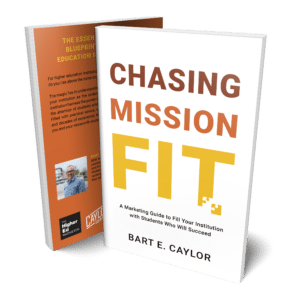Scaling AI Fluency for Marketing Teams: How ASU Leads with Innovation and Intent
See how ASU is leading AI fluency for marketing teams through leadership buy-in, innovation challenges, and custom tools that drive real, campus-wide impact.
Featured
Authenticity in higher ed marketing has to take a front seat because there is a lot at stake.
On the one hand, we have the massive challenges coming ever closer as we approach the enrollment cliff.
But there is another looming problem for higher education that isn’t as obvious to us on the marketing side.
More and more, higher ed institutions are finding it difficult to attract and retain good talent on their staffs.
Maybe you’ve already got this issue on your radar because you’ve struggled to find good talent to fill the vacancies on your marketing team, but you may not realize that the problem goes way beyond the challenges we face in rounding out our marketing talent.

Eddie Francis is the founder of Edify Ventures and has experience with a diverse group of industries working as a recruiter and consultant.
In our interview with Eddie, he emphasizes the need for authenticity in higher ed marketing, and it starts with improving the employee experience.
It may not be apparent on the surface, but these two problems of attracting talent and attracting students both require a new look at how we are communicating our values and mission to the world.
In this post, we dive into the mechanics of employee value and authentic culture with our guest, Eddie Francis.
At the beginning of our conversation, Eddie laid out the problem clearly and succinctly. “Higher Ed has a hiring problem.”
And that has led to “a legitimate talent crisis that higher ed is dealing with.”
Back in 2020, Eddie would look for a certain talent and get 200 applications. Today, he’s getting 30 applicants for the same job search.
If a recruiting professional like Eddie is finding it difficult to find good talent, certainly it’s even more difficult for all of us regular team leaders.
Since the lockdown of 2020, people have been empowered to work for themselves. They have started their own consulting agencies. They have found out ways to tell [colleges and universities], “I can do this job from home.”
And some campuses let you work from home, [but] other campuses have said, “No, you got to be on campus.”
Since 2020, there have been a lot of folks who said, “Yeah, okay, that’s fine. I don’t need to do this job. You don’t pay enough anyway, so I’ll just go do something else.”
That’s a shock to the higher ed system because higher ed has been used to people just coming to us and just applying for those jobs [knowing that higher ed offers greater job security than other institutions].
And higher ed isn’t seeing [that enthusiasm to come work for them] anymore.
Now they’re dealing with a bunch of empowered people in the workforce who are saying, “I really can do whatever I want with a good Internet connection.” People are opting out [of the physical workplace].
This feels similar to the way students are approaching education in what’s been called the “great resignation.”
Especially adult learners, they want more flexibility in the hours and location of their classes. As a result, online learning continues to grow at an increasingly rapid pace.
It’s not even just about the Internet connection. The other difficulty is social media.
People are sharing the amount of money that they stand to NOT make if they take a job at a particular college or university, especially for public institutions. [Because] that’s public information.
So now higher ed is in a spot where people are circulating the salaries around, and they’re saying, “You got to be joking!”
This makes for a very challenging hiring market as the workforce is demanding more in their salary and benefits from schools that are seeing their budgets shrink.
Right now, many higher education institutions are suffering from a poor employer brand.
They’re known for being stable employers, but they’re not known for being flexible.
In past generations, stability was more important to workers, but in today’s labor market, understanding the worker’s personal needs and being flexible is critical.
Higher ed has to think much differently about compensation, and I’m not talking about money. I [am referring to] a full compensation package.
You can’t tell somebody, “You have so many sick days.” [This new generation is] not going for that anymore.
When they see that an institution doesn’t have flexible policies around not only compensation, but it doesn’t have flexible policies around sick days and that sort of thing, [they tend to avoid applying to these places].
All people are asking is “Can you be more flexible?”
Eddie shared how a schoolteacher who had cancer didn’t have enough sick days available to recuperate from the disease. So, all his fellow teachers donated their sick days so that he could keep his job.
Citing the latest CUPA HR Higher Education Employee Retention Survey, Eddie pointed out that nearly 80% of the survey respondents were looking for new job opportunities.
Survey results highlighted the fact that most employees would stay if they…
One of the most important things that colleges and universities can build into their compensation packages [to increase employee retention] is professional development.
Pay for people’s professional development. Don’t be afraid that somebody is going to leave your institution. Be more concerned that they’re going to leave your institution and tell other people to never apply for a job over there.
People pay for what they want. If you really want to retain your talent, you’re going to pay for that.
This isn’t easy advice to hear for resource-strapped higher ed marketers, but it is cheaper to retain good employees than to be constantly looking for new talent.
Authenticity in higher ed marketing is one of the keys to success that we’ve been talking about in this blog.
For long-term success, it’s crucial to accurately express your mission and values as an institution so that you can attract mission-fit students.
Mission-fit students tend to stay long enough to graduate and then go on to become alumni advocates for your education brand.
The same principles for mission-fit marketing apply here as you’re trying to find mission-fit talent.
We still have a lot of people who are saying [to newly recruited talent], “Well, this is the mission of the institution, but don’t worry about the mission of the institution. Just come in here and get the job done.”
Well, Gen Z doesn’t think that way.
Gen Z is saying, “What’s the mission of the institution? You’re not living up to the mission, so why should I believe you? And why should I follow you? And why should I trust you?”
The answer to this disconnection between the mission of our institution and the daily reality is to seek more authenticity in our marketing so that new students are coming for the right reasons.
So, how do we infuse authenticity into our culture and our marketing?
[First of all], it’s not about what you see on the website. It’s not about what you see on social media.
It’s about the conversations taking place behind closed doors. Those [private] conversations are the real branding.
[You need to have] the actual conversation about what you value as an institution and expressing that in an honest way.
Let’s be clear. If your institution has an ADA issue, do not start putting a bunch of people who have disabilities on your collateral, as if you are the best ADA institution in the country. Don’t do it.
[You may have] just got wheelchair access to this one building. Okay. [But] you still got all kinds of stuff that you have to straighten out. The Department of Justice is on you right now. Your website isn’t compliant. You just have all these things missing.
Be honest with yourself and just say, “Let’s not put this on a collateral because we’re not there yet.”
Eddie points out that this also pertains to ethnic diversity.
If you don’t have an ethnically diverse staff or student body yet, don’t look for the one ethnically diverse person out of the whole college and place them on your collateral.
Be real.
I think [higher ed marketers] have to be honest. They have to realize that diversity in marketing has to tell an honest story. You have to do some honest work behind closed doors.
Every institution has a mission that is somehow directed to making people better. Lean into it.
Lean into the solution. Let that mission be your north star.
If you don’t think the mission is realistic for whatever reason, then make whatever adjustments you have to make to it.
Honesty takes hard work and hard conversations.
But that hard work really pays off as your marketing collateral becomes more authentic to who you really are.
The more authentic your marketing collateral, the more mission-fit talent you can attract to your institution.
Mission-fit talent, like students, will stay longer, give more of their effort, and produce at greater efficiency.
Listen to our full interview with Eddie Francis to get even more insights into:
And if you want more practical strategies on finding and retaining mission-fit students for your school, order my new book Chasing Mission Fit today!
The essential marketing book every higher education institution needs! If you are a higher education marketing professional seeking a fail-safe plan to make your institution stand out, “Chasing Mission Fit” is your guide.

So you can empower your institution with audience-focused marketing strategies, and attract mission-fit students who will flourish in your unique academic environment.
Ready to transform your institution’s marketing approach?
Order now!
Featured image by Insta_photos via Adobe Stock
Subscribe to The Higher Ed Marketer podcast today!